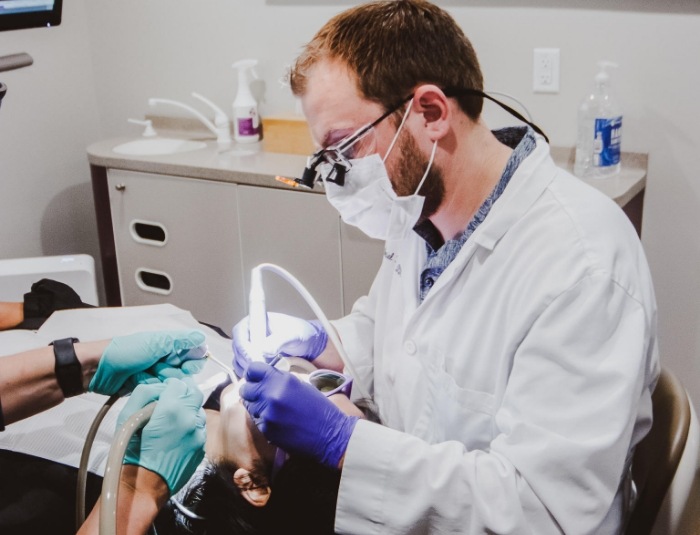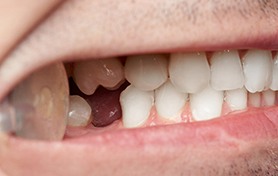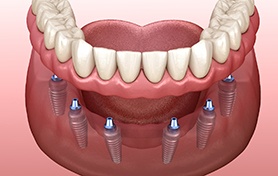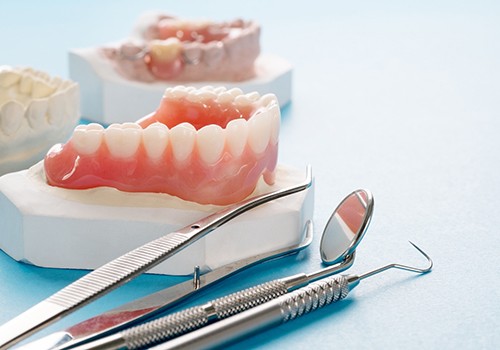Dentures – Phoenix, AZ
Get Your Full Grin Back


A life with missing teeth tends to be a challenging one. After all, lacking even a few pearly whites can make everyday tasks hard. The resulting smile gaps also cause oral health issues over time. Still, there’s a highly effective solution for tooth loss available: dentures in Phoenix! As provided by Complete Dental Care, these restorations make grins nice and full again. To learn more about them, continue reading or book a visit to our office.
Who’s a Good Candidate for Dentures?

If you feel the life-altering effects of tooth loss, you’re likely a good dentures candidate. Treatment best suits those who struggle to eat, speak, or smile when missing teeth. Still, keep in mind that not everyone with lost teeth needs dentures. Another option may be better if someone still has a few healthy teeth along an arch. Ultimately, the best way to know if dentures suit you is to consult Dr. Rodda. He’ll perform an initial oral exam to confirm your candidacy. Until then, here are some things for you to keep in mind.
Effects of Missing Teeth

Teeth are very strong. In fact, the enamel is the strongest substance in the entire body. However, it isn’t completely indestructible. The most common reasons behind tooth loss include tooth decay, gum disease, and trauma to the mouth. According to the American Academy of Periodontology, there are several negative health effects that you can experience from tooth loss. They include facial sagging, difficulty speaking, trouble eating, and lower self-esteem. When you replace your missing teeth with dentures, you can improve all of these things, therefore improving your overall quality of life.
What Qualifies You for Dentures?

Dentures are ideal for those who have experienced significant tooth loss. People who get dentures must also be committed to their dental health routine and willing to properly care for their replacement teeth. The number of teeth that you are missing and where they are located in the mouth will determine which type of denture is ideal for you. One of the great things about dentures is the fact that they are more affordable than other options, like dental implants. This makes them ideal for those who are unable to invest a lot of money into their smile at this time.
Alternative Tooth Replacement Options

If you aren’t a good candidate for dentures, or they don’t seem like they are up your alley, you might want to consider some other tooth replacement options that we offer. Here is how they work:
- Dental Bridges: A dental bridge works by “bridging” the gap with a replacement tooth using dental crowns on the adjacent teeth. This is great for patients who are only missing one or a few teeth. This method requires healthy teeth surrounding the missing one to support it.
- Dental Implants: A dental implant is a screw-like post that is surgically inserted into the jawbone to support a replacement tooth. This requires that the patient has a strong and sufficient bone structure. This option is more costly than dentures, but it is intended to last a lifetime!
Types of Dentures

As part of the consultation, Dr. Rodda will also explain the types of dentures on offer. He’ll suggest one of three possible kinds to ensure effective care. The possibilities include:
Partial Dentures
A partial denture (per its name) only replaces a few teeth at most. For that reason, it’s secured with metal clasps that attach to your natural pearly whites.
No matter the specifics, a partial denture has artificial teeth attached to an acrylic base. (The latter is gum-colored to ensure results blend well.) The overall fit should be snug, though poorly-made dentures sometimes feel loose.
Full Dentures
While a partial denture only switches a few, a full denture replaces an entire arch of teeth. That means it stays secure with suction, not metal clasps. The result is a treatment that doesn’t need to prep other teeth much.
Compared to a partial model, a full denture’s materials aren’t too different. This kind also relies on acrylic, gum-colored resin for its base. That said, labs often further customize a full denture to fit across an entire arch.
Implant Dentures
If you need something more stable than the usual options, you could try implant dentures. These are great for patients who aren’t big fans of traditional ones.
To be clear, implant dentures attach to dental implants — restorations surgically placed into the jawbone. As the latter root themselves in your jaw, they prevent your face from sagging or collapsing.
Their fusion also keeps your new teeth from slipping or falling out of your mouth.
How Dentures Are Made

Now that you know more about the different types of dentures available, it’s easy to see how this versatile solution can benefit you. If you’re eager to move forward, you should know that being fitted with dentures can take some time. The full process from start to finish happens in stages, so you might have to wait a few weeks for your artificial teeth to be completed. Keep reading to learn more about how they’re made and why it’s worth taking the time to create a quality restoration. If you have questions or would like more information, feel free to contact us and we’d be happy to assist you.
What Are Dentures Made Of?

Dentures include two distinct parts: the base and the pontics (artificial teeth). More information about each component can be found below.
- Denture base. This is the foundation for your restoration that holds the artificial teeth in place. It can be made from a variety of materials such as acrylic, nylon, porcelain, resin, or metal. Typically, full dentures have an acrylic base because it can be customized to match your natural gums for a more lifelike appearance. Partial dentures often use metal clips in conjunction with acrylic so that they can attach to your teeth. Sometimes nylon is used in place of acrylic.
- Artificial teeth. These pontics are usually made from porcelain or composite resin because they reflect light in a way that closely resembles natural enamel. In many cases, porcelain is preferred because of its appearance as well as durability. It’s not always used for partial dentures, however, because it can be abrasive against neighboring teeth.
The Denture Creation Process

Your dentures are completely tailor-made just for you, so there are several steps involved in making a good-quality set. Typically, the different stages include:
- Step 1: Our team will take impressions of your upper and lower gums using a thick paste that you bite into. This is used to make a plaster model of your mouth that will be used to create your artificial teeth.
- Step 2: This cast is sent to a lab where your dentures will be created. They start by building a wax version of your gumline on this mold.
- Step 3: The pontics are set into place with a mechanical device known as an articulator. It attaches the artificial teeth to the wax, which a technician will then sculpt to look like your gums.
- Step 4: The wax dentures are returned to Dr. Rodda so that you can come in for a fitting. If everything fits as intended, they’ll be sent back to the lab for completion. You’ll be given a temporary set to wear in the meantime while your permanent ones are finalized.
- Step 5: The lab technician boils the dentures to remove the wax. They do this by placing the dentures in a flask with plaster (to maintain the shape of the dentures), which is placed in hot water.
- Step 6: Holes are put into the pontics so the material attaches properly. Then, a liquid separator is inserted into the plaster layer to keep the acrylic from sticking to it. Then, acrylic is injected into the flask to replace the now-melted wax.
- Step 7: The technician carefully removes the plaster with specialized tools to reveal the acrylic dentures. Then they’re placed in an ultrasonic bath to ensure they’re completely clean.
- Step 8: Any excess acrylic is trimmed away and then the dentures will be polished.
- Step 9: This final set is sent back to Dr. Rodda for a final fitting. From there, he’ll work with you to make any final adjustments to ensure your dentures are ready to go.
Adjusting to Your New Dentures

It can also take some time to grow accustomed to your new dentures, so give yourself some time and patience. Many patients experience mild soreness at first, and you might also have some initial challenges eating and speaking. Then, after about a month, the muscles in your mouth adjust and you shouldn’t have any problems chewing and talking around your restoration. They’ll feel so natural that you might even forget they’re there. If you continue to have issues with them staying put or have prolonged discomfort, contact us so Dr. Rodda can ensure that they fit properly.
The Benefits of Dentures

Once you have dentures from Phoenix, you’ll experience many of their upsides. These typically include the following:
- Natural-looking Results – Given advanced dental technology, today’s dentures look lifelike and natural. Consequently, you can trust them to blend seamlessly with your surrounding teeth and gums.
- Better Eating – Whether implant-based or not, dentures can restore some of your ability to chew food. They’ll thus help you eat a healthier, wider-ranging diet.
- More Confidence – Naturally, dentures can boost your confidence by filling in your unsightly smile gaps.
- Strong Lifespan – Dentures can actually last over a decade with proper care!

